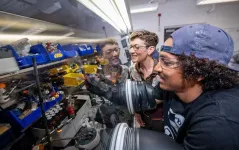(Press-News.org) Researchers from Johns Hopkins Medicine propose a novel approach to addressing the pressing issue of a kidney donor shortage through findings that suggest a promising method to expand the pool of available kidney donors by utilizing deceased donors on dialysis for kidney transplants.
The findings, published in the May 23rd issue of JAMA, identifies that while those who received such kidneys experienced a “significant delay” in the function of the transplanted organ compared to those whose donors did not have dialysis, there was no significant difference in rates of transplant failure or death.
According to the United Network for Organ Sharing, (UNOS) approximately 100,000 patients are on the waiting list for kidney transplants in the United States. Some 25,000 successful kidney transplants were performed in 2022, the latest year for which complete data are available, and it is estimated that fewer than 20,000 of those on the list will receive transplants from deceased donors.
Historically, according to UNOS, more than 20% of deceased donor kidneys are not used each year, largely several of them are not utilized due to concerns that acute kidney injury (AKI) in the kidneys and dialysis used to treat the donors renders the kidneys too damaged for transplantation.
However, recent studies suggest there might not be much long-term difference between how the organ recipient’s body responds to a deceased donor kidney exposed to dialysis prior to transplant surgery and a diseased donor kidney not exposed to dialysis before transplant surgery.
These deceased donors are receiving dialysis treatment because they have severe AKI around the time of their death. It is known that kidneys with AKI are at a higher risk of delayed graft function (DGF) in recipients—a term for when the transplanted kidney does not work right away. What has been unclear, is whether DGF predicts shortened life expectancy and organ function over the long term.
Suppose studies prove that the risks associated with the transplantation of kidneys from deceased donors on dialysis are minimal in regard to long term life expectancy of the graft and quality of life of the recipient. In that case, this will go a long way toward increasing the number of available kidney donors.
“With patients waiting many years to receive a kidney, and a significant portion of them deteriorate or succumb to their condition while on the waiting list, we need to rapidly increase the pool of available kidneys,” says Chirag Parikh, M.D., Ph.D., professor of medicine and the director of the division of Nephrology at Johns Hopkins Medicine and key investigator for the study.
For the study, researchers analyzed medical records for 1,944 kidney transplant patients gathered from 58 U.S. organ transplant organizations from the years 2010 and 2018 with 954 receiving kidneys from deceased donors who underwent dialysis and matched them to 990 receiving kidneys from deceased donors who had not undergone dialysis.
Results showed there was higher incidence of DGF in patients who received kidneys from donors who were deceased and who underwent dialysis than there was for patients with kidneys from donors who were deceased and who did not receive dialysis. However, the kidney recipients with higher DGF did not show any significant differences in long-term graft failure (permanent loss of function of the transplanted organ).
“There is significant variability in the utilization of kidneys from high risk deceased donors across the country,” Parikh says. “The findings from this study should encourage organ procurement organizations and transplant professionals to cautiously bring kidneys with severe AKI, from deceased donors who received dialysis, into the allocation pool.”
Along with Dr. Parikh, members of the study team from Johns Hopkins Medicine are Yumeng Wen, MD, PhD; Nitya Srialluri, MD, MS, MHS, and Heather Thiessen Philbrook, M, Math.
Funding for the study was provided by the National Institute of Diabetes and Digestive and Kidney Diseases (NIDDK) grant T32DK007732-27, grant U01DK-116097, grant U01DK-116066, grant R01DK-126739, and grant U01DK130058, the National Institute on Minority Health and Health Disparities grant R01MD-014161, the National Institute of Biomedical Imaging and Bioengineering grant R01EB-032910; grants R01DK-123041, U01DK-126654, and U01DK-110961, the National Institute of Allergy and Infectious Diseases grant K24AI-146137; the NIDDK and grant P30DK079310 from the George M. O’Brien Kidney Center at Yale University grants R01DK-93770, K24DK090203 and grant P30DK079310.
END
New research supports expansion of kidney donation to include organs from deceased patients who once had dialysis
2024-05-28
ELSE PRESS RELEASES FROM THIS DATE:
A cleaner way to produce ammonia
2024-05-28
– By Rachel Berkowitz
Ammonia is the starting point for the fertilizers that have secured the world’s food supply for the last century. It’s also a main component of cleaning products, and is even considered as a future carbon-free replacement for fossil fuels in vehicles. But synthesizing ammonia from molecular nitrogen is an energy-intensive industrial process, due to the high temperatures and pressures at which the standard reaction proceeds. Scientists from the Department of Energy's Lawrence Berkeley ...
How killifish embryos use suspended animation to survive over 8 months of drought
2024-05-28
The African turquoise killifish lives in ephemeral ponds in Zimbabwe and Mozambique. To survive the annual dry season, the fish’s embryos enter a state of extreme suspended animation or “diapause” for approximately 8 months. Now, researchers have uncovered the mechanisms that enabled the killifish to evolve this extreme survival state. They report May 30 in the journal Cell that although killifish evolved diapause less than 18 million years ago, they did so by co-opting ancient genes ...
Harnessing green energy from plants depends on their circadian rhythms
2024-05-28
WASHINGTON, May 28, 2024 —When plants draw water from their roots to nourish their stems and leaves, they produce an electric potential that could be harnessed as a renewable energy source. However, like all living things, plants are subject to a circadian rhythm — the biological clock that runs through day and night cycles and influences biological processes. In plants, this daily cycle includes capturing light energy for photosynthesis and absorbing water and nutrients from the soil during the day and slowing its growth processes at night.
In a study published this week in ...
Financial burden of health care in the privately insured US population
2024-05-28
About The Study: In this national cross-sectional study of privately insured U.S. families, inflation-adjusted health care spending increased from 2007 to 2019, largely owing to increasing contributions to premiums. Annual financial medical burden increased significantly, both overall and among low-income and higher-income families. Mean financial medical burden was more than 26% of postsubsistence income for low-income families, compared with approximately 6% for higher-income families.
Corresponding ...
Mortality risk among women with premenstrual disorders in Sweden
2024-05-28
About The Study: The findings of this matched cohort study suggest that women with premenstrual disorders are not at increased risk of early death overall. However, the risk was elevated among young women and for death by suicide. This supports the importance of careful follow-up for young patients and highlights the need to develop suicide prevention strategies for all women with premenstrual disorders.
Corresponding Author: To contact the corresponding author, Marion Opatowski, Ph.D., email marion.opatowski@ki.se.
To access the embargoed ...
Early vs late anticoagulation in minor, moderate, and major ischemic stroke with atrial fibrillation
2024-05-28
About The Study: The treatment effect of early direct oral anticoagulant initiation did not differ in people with minor, moderate, or major stroke assessed by brain imaging. Early treatment was not associated with a higher rate of adverse events, especially symptomatic intracranial hemorrhage, for any infarct size, including major stroke.
Corresponding Author: To contact the corresponding author, Urs Fischer, M.D., M.Sc., email urs.fischer@insel.ch.
To access the embargoed study: Visit our For The Media website at this link https://media.jamanetwork.com/
(doi:10.1001/jamaneurol.2024.1450)
Editor’s ...
Air and noise pollution exposure in early life and mental health from adolescence to young adulthood
2024-05-28
About The Study: Early-life air and noise pollution exposure were prospectively associated with three common mental health problems (psychotic experiences, depression, and anxiety) from adolescence to young adulthood in this longitudinal cohort study. There was a degree of specificity in terms of pollutant-timing-outcome associations. Interventions to reduce air and noise pollution exposure (e.g., clean air zones) could potentially improve population mental health. Replication using quasi-experimental designs is now needed to shed further light on the underlying ...
New research shows soil microorganisms could produce additional greenhouse gas emissions from thawing permafrost
2024-05-28
As the planet has warmed, scientists have long been concerned about the potential for harmful greenhouse gasses to seep out of thawing Arctic permafrost. Recent estimates suggest that by 2100 the amount of carbon dioxide and methane released from these perpetually frozen lands could be on par with emissions from large industrial countries. However, new research led by a team of Colorado State University microbiome scientists suggests those estimates might be too low.
Microorganisms are responsible for the process that will generate greenhouse gasses from thawing northern peatlands, which contain about ...
Introducing peanut in infancy prevents peanut allergy into adolescence
2024-05-28
Feeding children peanut products regularly from infancy to age 5 years reduced the rate of peanut allergy in adolescence by 71%, even when the children ate or avoided peanut products as desired for many years. These new findings, from a study sponsored and co-funded by the National Institutes of Health’s National Institute of Allergy and Infectious Diseases (NIAID), provide conclusive evidence that achieving long-term prevention of peanut allergy is possible through early allergen consumption. The results were published today in the journal NEJM Evidence.
“Today’s findings should reinforce parents’ and caregivers’ ...
Light-activated drugs targeting adenosine A2A receptors in the brain that induce sleep
2024-05-28
Tsukuba, Japan—The nucleus accumbens plays a pivotal role in motivational behavior and sleep regulation, modulated by adenosine A2A receptors (A2AR). Hence, selective A2AR regulation within this brain region could control sleep and motivation. However, A2ARs are distributed across various organs, including the heart, posing challenges for precise brain-specific modulation without genetic interventions.
A research team led by Professor Michael Lazarus and Associate Professor Tsuyoshi Saitoh (TRiSTAR Fellow) from the Institute of Medicine and the International Institute for Integrative Sleep Medicine (WPI-IIIS) at the University ...



